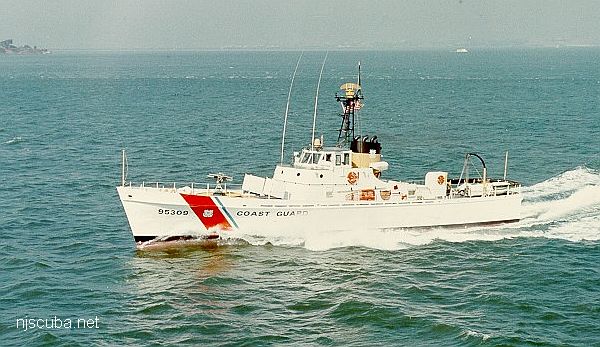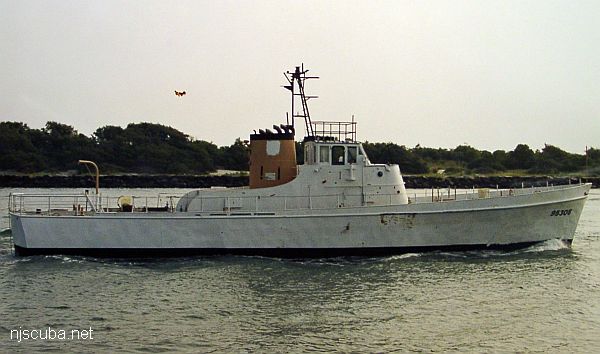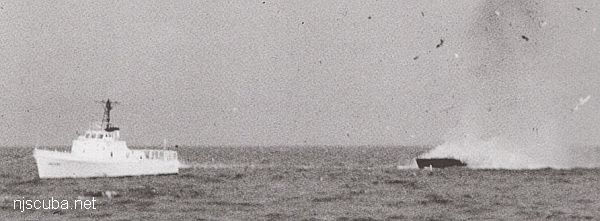Cape Straight WPB-95308

- Type:
- artificial reef, cutter, US Coast Guard
- Built:
- 1953, US Coast Guard Yard, Baltimore MD USA
- Specs:
- ( 95 x 20 ft )
- Sponsor:
- USCG, New Jersey State Police
- Sunk:
- Thursday September 9, 1993 - Cape May Artificial Reef
- GPS:
- 38°51.060' -74°42.125'
- Depth:
- 65 ft

The 36 vessels in the Cape class patrol boats (WPB) were 95-foot steel hull patrol boats with aluminum superstructures. They were unnamed until 1964, when they acquired names of United States capes of land. Originally designed for anti-submarine warfare, all 36 boats in this class were built at the United States Coast Guard Yard in Curtis Bay, Maryland during the 1950s.
CAPE STRAIT, WPB 95308 ( Type A )

The 95-foot or Cape class was an outgrowth of a need for shallow-draft anti-submarine-warfare (ASW) craft brought on by the increasing tensions during the years immediately following World War II.
During the period of construction, three distinctive sub-classes evolved as the Coast Guard's mission emphasis shifted from ASW to search and rescue (SAR), the A-Type 95-footer was outfitted primarily for ASW. The B-Type differed by mounting a 40 mm vice 20 mm gun and being fitted with scramble nets, a towing bit, and a large searchlight - all important SAR tools. The C Type units were constructed without the heavy armament and for economy, some of the SAR equipment was also deleted. However, the Coast Guard added these SAR items to both the As and Cs during various refits. A renovation program began in the mid-1970s but was ended, due to increasing expenses and a shortage of funds, after 16 boats had been overhauled.
The 95-footers were designed by the Coast Guard, and their hulls and superstructure were made of steel. These cutters remained unnamed until January of 1964.
From 1953 to 1983, the Cape Strait was stationed at Fort Tilden (Staten Island), NY, and was used for law enforcement and SAR. In 1963, she was temporarily deployed to Florida as a follow-up measure to the Cuban missile crisis. In November 1964, she assisted in the rescue of survivors from the Norwegian M/V Stolt Dagali. On 2 May 1967, she escorted the disabled F/V Marjorie Dorothy to Brooklyn, NY. On 11 August 1970, she towed the disabled F/V Great Eastern 20 miles east of Seaside Park, NY, to Fire Island.
In March 1980, she shadowed the suspected drug runner Jose Gregorio and passed on surveillance to the cutter Vigorous 50 miles south of Montauk Point. In early summer 1980, she was deployed to Florida waters during the Cuban exodus. On 17 August 1980, she assisted in fighting fire on board F/V Tiny Tim off Rockaway, NY.
Builder: Coast Guard Yard, Curtis Bay, MD
Commissioned: 10 September 1953
Decommissioned: 21 January 1983
Disposition: Training hulk, Cape May, NJ; eventually sunk as an artificial reef off New Jersey.
Length: 95' oa; 90' wl
Navigation Draft: 6'4"
Beam: 20' max.
Displacement (tons): 102 fl (A)
Main Engines: 4 Cummins VT-600 diesels; 2 Detroit 16V149 diesels (renovated)
BHP: 2,200; 2,470 (renovated)
Performance, Max. Speed: 20 kts.; 24 kts. (renovated)
Performance, Cruising: 12 kts., 1,418-mi radius (1961)
Fuel Capacity: 3,114 gallons
Complement: 15 (1961)
Electronics:
Radar: SPS-64 (1987)
Sonar: retractable type
Armament: 2 mousetraps, 2 depth charge racks, 2 20mm (twin), 2 .50-cal. machine guns (as completed). 2 12.7mm mg, 2 40mm Mk 64 grenade launchers (1987)
-- from Coast Guard historical records

The upper works of the Cape Straight were completely destroyed during sinking. A 46 ft buoy tender, the "Johnny Buoy", was tethered to the larger vessel and sunk at the same time.




Questions or Inquiries?
Just want to say Hello? Sign the .